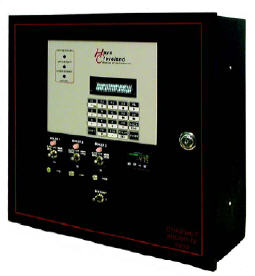Boiler Sequence Control
 Introduction
Introduction
Many facilities have more than one boiler for redundancy/reliability, such as schools and hospitals. Other facilities have installed or retrofitted to multiple, modular boilers for various reasons other than energy efficiency. (First cost, space considerations, operator codes, etc.) If boilers are not optimized for efficiency, there is potential energy savings from installing an intelligent boiler sequence control.
A sequence control should be more than just an ‘on-off’ and ‘which boiler starts first’ control. The desired model should consider load conditions and match load with the most efficient combination of boiler capacity according to a program unique to each boiler room. Most boilers are the most efficient at full load; however, not all suffer part-load efficiency reductions. Load response and start-up times are also factors. The controller should ‘know’ whether it is better to run 2 boilers at 1/2 fire in order to better match rapidly changing loads, or 1 boiler at full fire for peak efficiency.
The benefits for installing a boiler sequence control include:
-
Complete automation for startup and shutdown of the boilers and control of the main steam header pressure or header temperature.
-
The steam or hot water supply for a facility is controlled precisely. Without the controller each boiler operates at its pressure or temperature and not the main header pressure or temperature.
-
Boiler life is improved since each boiler can operate as the lead boiler for equal hours of operation. The lead lag sequencer will change the lead boiler based on operating hours or date and time.
-
Fuel savings by eliminating idle time at low fire.
Operation
From the Hays Cleveland data sheet for boiler sequence controls:
-
 Maintains facility main header temperature or pressure for efficient production and heating: eliminates variable energy supply and meets demand!
Maintains facility main header temperature or pressure for efficient production and heating: eliminates variable energy supply and meets demand! -
Universal applications: controls any model burner or boiler.
-
Use Model C-05830 Compact Micro IV™ for up to six boilers. Model C-05810 Micro IV™ handles additional boilers with added features such as flue gas monitoring.
-
Sequencing with modulation for steam or hot water boilers and auxiliary boiler plant equipment.
-
On-Off, Low-High-Off or Full-modulation.
-
Time-based main header temperature or pressure control: fully factory-configured before shipment.
-
Fully Automatic control & burner interface.
-
Building Management (EMS) interface with ASCI-II and RS-485 Modbus ports for remote control, data acquisition and SCADA systems.
-
Master set point tracking.
-
Real-time data acquisition including firing rates, lead boiler run time, pressures, and temperatures.
-
Bright Vacuum Fluorescent Display: 2 easy-to-read lines using engineering units.
-
Front panel operator interfaces include boiler ON lights, engineering unit displays of boiler operation functions, manual/auto/off switches, dedicated display of header temperature or pressure.
-
Five lead-boiler rotation modes: manual selection (via keypad entry); automatic rotation on a weekly basis; automatic rotation based on lead-boiler run time; or remote select with Modbus or switched inputs.
-
Night set-back/weekend skip: real-time clock for automatic set point reduction during lighter load periods.
-
Packaged systems ready for installation! Systems include field sensors and installation start-up instructions.
Features
-
Automatic control transfer upon CPU failure: returns operating control to the individual boiler controls.
-
Selectable series or parallel modulation modes. Series modulation varies the firing rate of only the last boiler brought on-line, while holding other online boilers at their throttle back setting. Parallel modulation varies all online boilers at the same firing rate.
-
Throttle-back base-loading is used in the series modulation mode. On-line boilers are automatically throttled back to their own selectable firing rate when each additional lag boiler is brought online.
Boiler sequence controllers can be used stand-alone or in combination with O2 Trim controls.
Economics
According to Charles Rowan, V-P Sales at Hays-Cleveland:
The investment for lead lag sequencers for two to four boilers is:
-
Equipment: Lead lag sequencer in a surface mount cabinet with standard features such as automatic transfer on boiler fault, auto/off/manual switches, night set back/ weekend skip, automatic lead boiler selection and a header pressure or temperature sensor. The equipment cost range is $5,500.00 to $6,500.00.
-
Installation Costs: $3,000.00 to $4,000.00.
-
Startup & Training Services: $1,500.00 to $3,000.00.
To estimate the fuel savings by eliminating the time for idle at low fire, use this formula:
Steam Flow (lbs/hr) X 1,000 BTU/lb X Fuel Cost ($/MMBTU) X Hours of Idle Time
Boiler Efficiency At Low Fire X Boiler Turn Down
For example: A boiler with a capacity of 10,000 lbs/hr, turndown of 4/1, idle time of 10% of the annual operation (876 hours), an efficiency of 80% at low fire and a fuel cost of $7.00 per million BTU would save $19,163 per year.
10,000 lbs/hr x 1,000 BTUs/lb x $7.00/MMBTUs x 876 hours
0.8 x 4 x 1,000,000 BTUs
 More Information
More Information
Manufacturers
Hays Cleveland
1903 South Congress Avenue
Boynton Beach FL 33426
Telephone: ![]() 561-734-9400
561-734-9400
Fax: 561-734-8060
1111 Brookpark Road
Cleveland, OH 44109
Telephone: ![]() 216-398-4414
216-398-4414
Fax: 216-398-8558
Go to their web site at www.hayscleveland.com
Boiler Automation Systems
Source: Text compiled by Bob Fegan 2-2005; images from Hays Cleveland 2-2005; product images and descriptions from manufacturer’s web sites linked above; modular boiler photo by Bob Fegan; Economics section provided by Charles Rowan of Hays Cleveland 3/2005;
